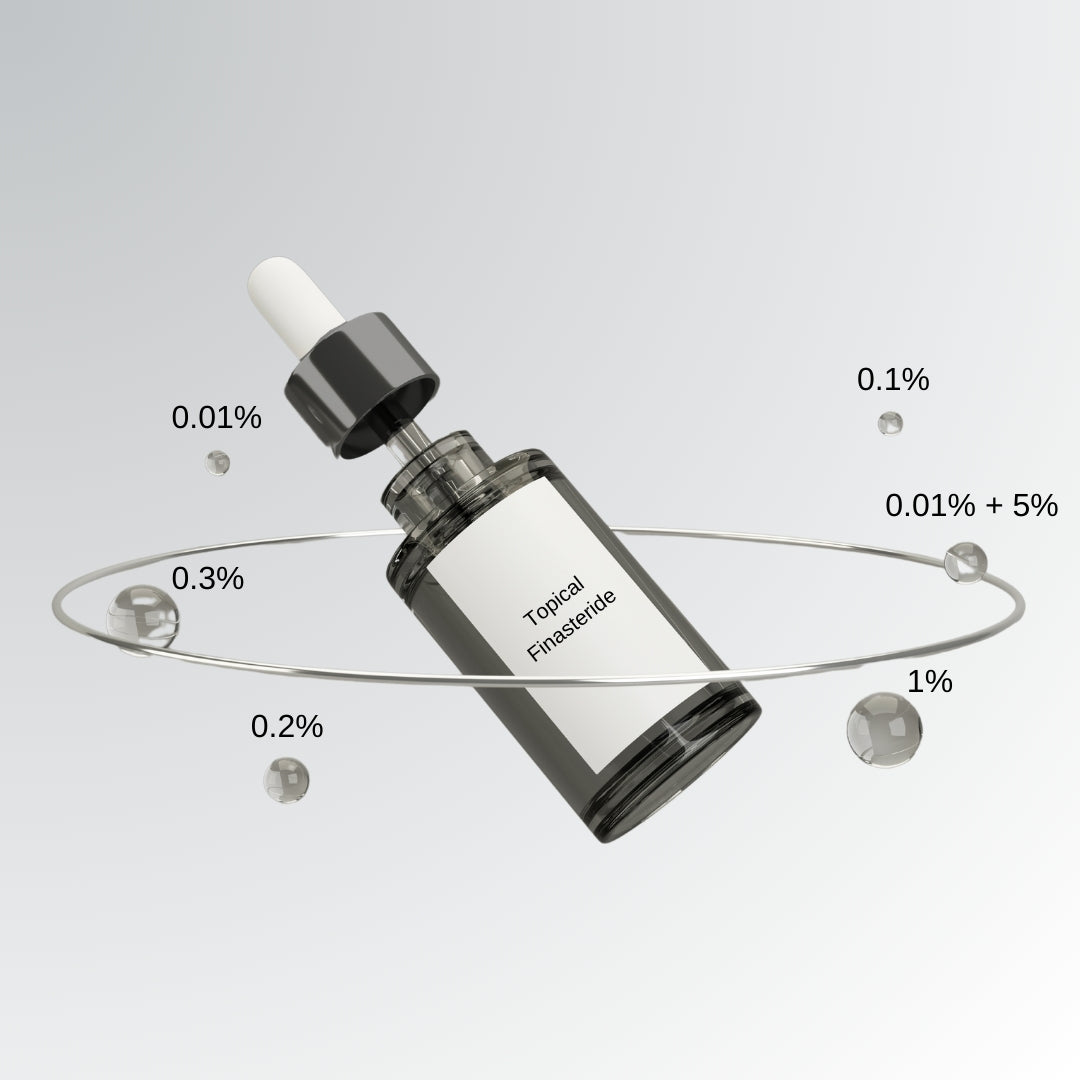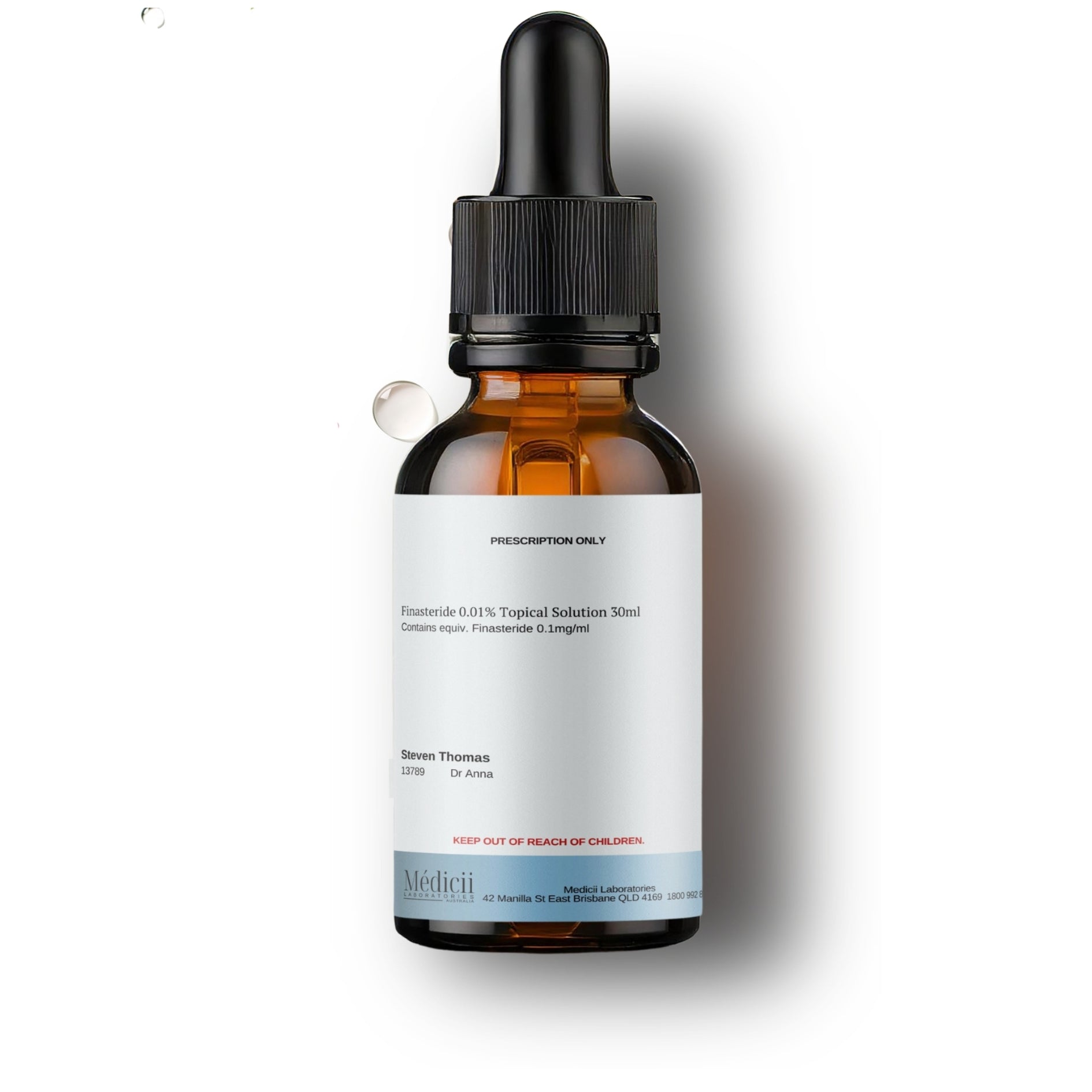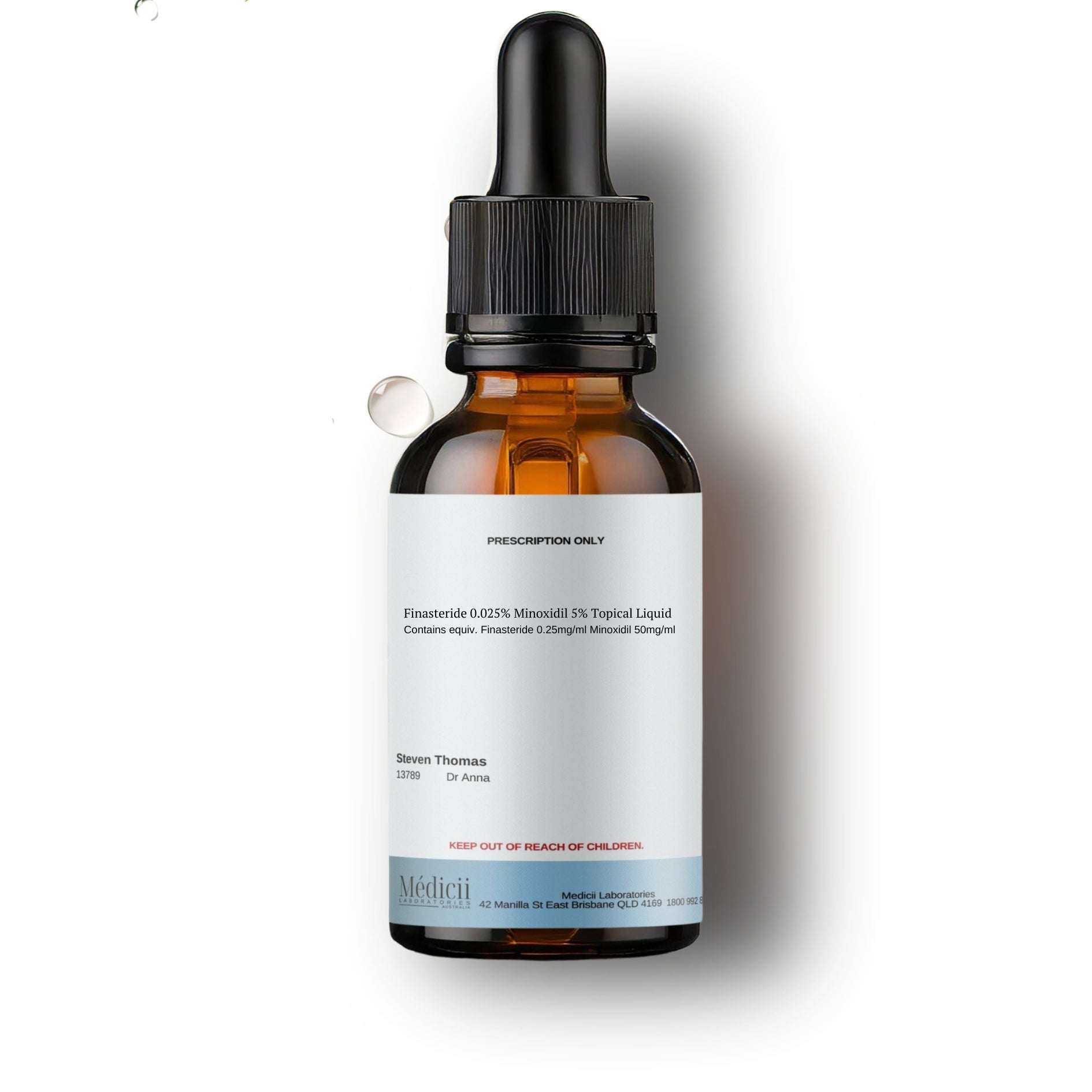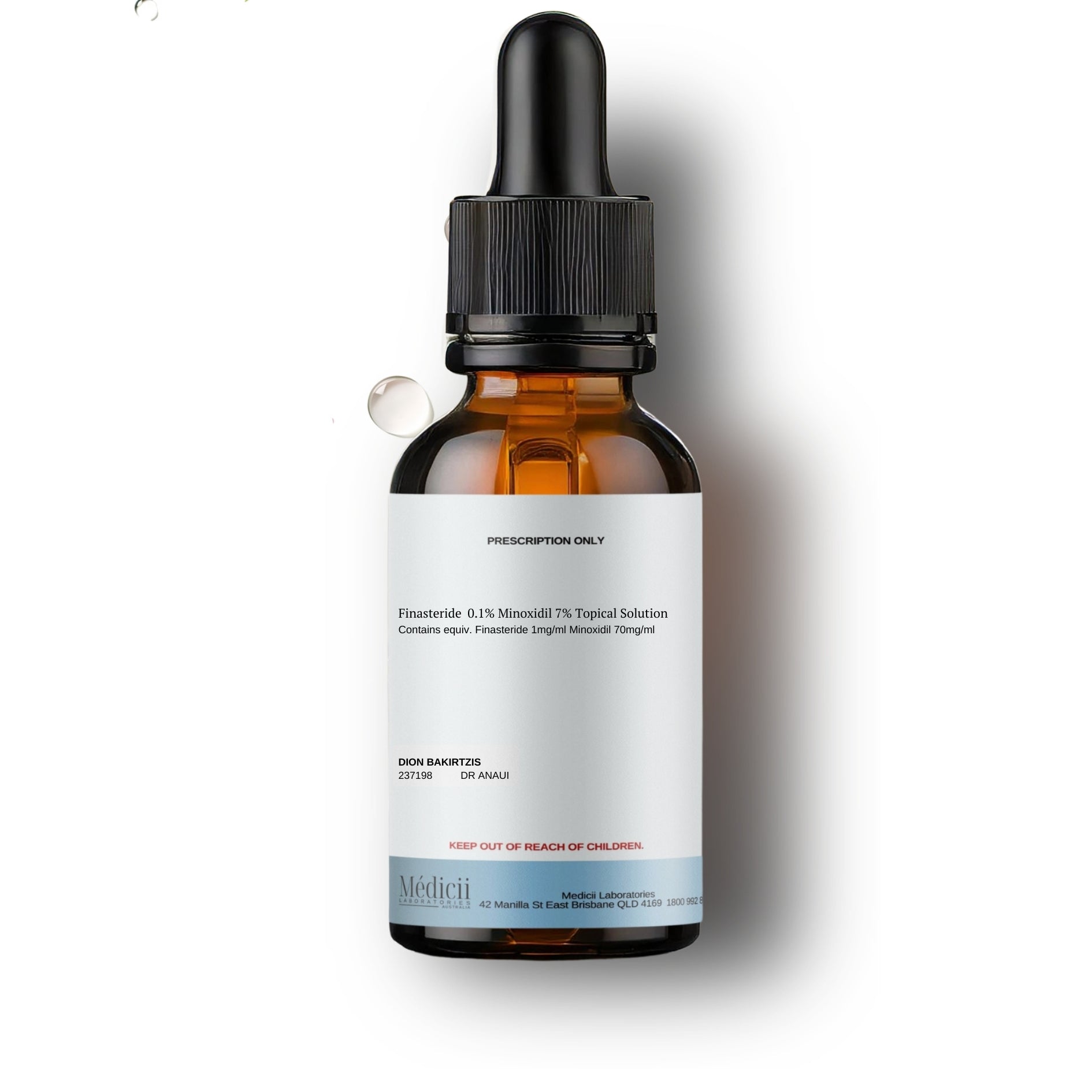
Finasteride Topical Solution - What is the Perfect Dose?
Oral Finasteride is a well-established and effective treatment for men with androgenic alopecia (AGA), but therapy is not always acceptable to patients due its side effects. The side effects which may be experienced from oral Finasteride include:
• Reduced sperm count
• Reduction in libido
• Erectile dysfunction
• Depression
• Breast tenderness
This article will aim to explore:
• The history of Finasteride,
• Clinical studies comparing the efficacy and safety of topical Finasteride compared with oral Finasteride,
• How topical finasteride can go systemic, and
• What is the ideal dose of topical Finasteride for men.
What is Finasteride?
Finasteride is a competitive inhibitor of types II and III 5-alpha-reductase isoenzyme. This inhibits the conversion of testosterone to dihydrotestosterone (DHT). DHT is the most potent hormone among the androgens and is considered a pure androgen. Unlike other androgens, DHT cannot convert into oestrogen.
Research has shown that Finasteride reduces prostatic DHT levels by up to 90% and serum DHT levels by a staggering 70% just by inhibiting the 5-alpha-reductase enzyme. Its potent effects on prostatic DHT levels makes it the drug of choice for treating prostate enlargement in men. The DHT lowering effects of Finasteride is also dose dependant.
"If you inhibit the conversion of testosterone to dihydrotestosterone, then men would have more testosterone, so isn't this a good thing?"
It's not quite so simple. Compared to testosterone, DHT has approximately double the binding affinity to the androgen receptor and a dissociation rate about five times slower (this means it hangs around for a lot longer). DHT plays a critical function in the sexual development of males and the role of DHT differs as males progress throughout adult life.
Low serum DHT levels has been associated with reduced libido, depression, weight gain and lethargy. In a perfect world, you want a nice balance of testosterone and dihydrotestosterone.
Figure 1 (below): How Finasteride works.

Drake and Hordinsky et al showed that serum DHT levels are significantly reduced even with low dose oral Finasteride. A study conducted in 249 men with androgenetic alopecia underwent scalp biopsies before and after receiving 0.01mg, 0.05mg, 0.2mg, 1mg and 5 mg daily of oral finasteride or placebo for 42 days. The results found scalp skin DHT levels declined by 13.0% with placebo and by 14.9%, 61.6%, 56.5%, 64.1%, and 69.4% with 0.01mg, 0.05mg, 0.2mg, 1mg, and 5 mg doses of finasteride, respectively.
Serum DHT levels declined significantly (P<.001) by 49.5%, 68.6%, 71.4%, and 72.2% in the 0.05mg, 0.2mg, 1mg and 5 mg finasteride treatment groups, respectively.

Clinical studies comparing different Finasteride solutions
Due to the adverse effects of oral Finasteride, many researchers have embarked on new ventures to compare different forms of Finasteride. The first study on topical finasteride was completed in 1997 by Mazarella et al. as a single-blind, placebo-controlled study, including 28 males and 24 females patients with AGA for sixteen months. The Subjects were randomly split into two groups:
• Group 1 - Received 1.0 mL topical Finasteride 0.005% solution twice daily
• Group 2 - Received 1.0ml placebo twice daily
Blood samples revealed no significant change in plasma levels of total testosterone, free testosterone, and DHT between the groups.
At sixth months, the researchers observed a significant decrease in the rate of hair loss in Group 1 compared to the placebo group.
The most recent study published in February 2022 involved 458 men (328 completed the study) over 24 weeks. This was a multi-centre, randomized, double-blind, placebo-controlled study in men with AGA. The experimental drug was topical Finasteride 0.25% w/v (concentration of 2.275 mg/mL) delivered using a spray applicator with a plastic cone to prevent air dispersion. Each spray delivers 50 µL to 400 µL of finasteride solution, equivalent to Finasteride 0.114 mg to 0.912mg. This illustrates that a topical spray may be easier to use but there is no dose consistency.
Study comparing oral finasteride 1mg vs placebo capsule vs topically applied finasteride solution.
Oral Finasteride 1 mg was the reference drug for systemic exposure with the matching oral placebo (an inert powder-filled capsule). Pirracini et al concluded change from baseline in target area hair count (TAHC) at week 24 was numerically similar between topical and oral finasteride, however, lower systemic exposure and less impact on serum DHT concentrations was observed in favour of the topically applied solution.

How systemic exposure can occur with topical Finasteride
Systemic exposure to topical Finasteride can occur due to:
• Drawing too much into the dropper. Finasteride has a dose-dependant response curve so a little extra Finasteride can produce a big response,
• The strength/dose is too high for the individual,
• The formulation. Hydroalcoholic formulations have been found to improve the absorption of Finasteride compared to Liposomal and aqueous (water) formulations. It is thought that alcohol disrupts the surface of the skin, allowing better drug penetration.
• Application device - In the most recent study conducted, a topical spray was used containing Finasteride 2.275mg/ml but only 50 µL of solution was delivered due to air dispersion. If the same person applied the exact same dose in a topical solution, the systemic exposure would increase significantly due to the absence of air dispersion. Finally,
• The frequency - twice daily application has shown to have a larger impact on serum DHT and therefore daily application is preferred.
What is the ideal dose of topical Finasteride for men?
Due to differences in pharmacokinetics (how our body metabolises a drug), the ideal dose of Finasteride will be different for each individual. The safest approach is always start low and titrate your dose as needed.
Setting aside any cognitive biases, the large multi-centre study published by Pirracini et al demonstrated two interesting points:
- The range that showed to improve hair count with less impact on serum DHT was 0.114mg to 0.912mg.
- Spray pumps have a higher margin for error.
Author: Helen Huynh B.Pharm MPS
References:
1) Mazzarella GF, Loconsole GF, Cammisa GA, Mastrolonardo GM, Vena G. Topical finasteride in the treatment of androgenic alopecia. Preliminary evaluations after a 16-month therapy course. J of Derm Tr. 1997;8(3):189–92. DOI: 10.3109/09546639709160517.
2) Caserini M1, Radicioni M, Leuratti C, et al. A novel finasteride 0.25% topical solution for androgenetic alopecia: pharmacokinetics and effects on plasma androgen levels in healthy male volunteers. Int J Clin Pharmacol Ther. 2014;52(10):842–9
3) Tabbakhian M, Tavakoli N, Jaafari MR, Daneshamouz S. Enhancement of follicular delivery of finasteride by liposomes and niosomes 1. In vitro permeation and in vivo deposition studies using hamster flank and ear models. Int. J Pharm 2006. October 12; 323(1–2):1–10
4) Pirracini, B et al. Efficacy and safety of topical finasteride spray solution for male androgenetic alopecia: a phase III, randomized, controlled clinical trial. J Eur Acad Dermatol Venereol. 2022;Feb;36(2):286-294.
5) Drake L, Hordinsky M et al. The effects of finasteride on scalp skin and serum androgen levels in men with androgenetic alopecia. J of American Dermatology. 1999 Oct;41(4):550-4.












